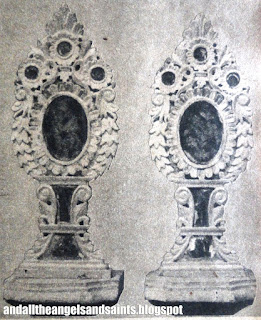Originally published on 2 January 1959, Weekly Women’s Magazine
A local newsman on being shown the ruins of the Pantheon in Acropolis during the course of a conducted tour of the once mighty isle of Greece remarked to his guide in mock disbelief,”You mean these ruins have been here for hundreds of years and you haven’t done anything about them? Why, look at Manila. It was razed to the ground during the last war but look at it now.”
Although said in fun, this remark is indicative of the attitude of a majority of our people. One of the latest to deplore this lack of artistic values is Prof. Galo Ocampo of the University of Santo Tomas’ College of Fine Arts, who is one of the country’s foremost painters.
Designated by Archbishop Rufino J. Santos of Manila to collect religious antiques for an archdiocese museum which has been given ample space in the new Cathedral building.
Prof.Ocampo laid slow siege on old parish churches throughout the country. The results were not very encouraging. Not because there is a dearth of religious antiques in the Philippines, for sacristies throughout the islands hold a wealth of liturgical items and religious objects of arts, but because custom and habit have contributed to the mutilation of these remaining heirlooms.
Take a typical Filipino town getting ready for its annual town fiesta. Since the reason for a town fiesta is very often, if not always a religious one, a procession is usually the order of the day. Now.processions must have images or statues of saints to grace the occasion; so the townspeople either acquire anew statue or look over their stock of blessed facsimiles.
They find an anay-infested wood-carved image, aged but whose delicate workmanship is still in evidence. To the horror of people like Prof. Ocampo, they cover it with a garish coat of silver paint, which to these simple people is like restoring it to new life.
Or take the once dignified façade of a local parish church. The cracks in the stone carved wall do not please the devout, church-going parishioners; so they patched it up with more paint and galvanized iron, all, of course, with the best of intentions.
In all fairness to the town fiesta devotee, it must be mentioned here that this naivete is not confined to this country alone but to other countries as well.
This disheartening (both to the collector and the artist) state of affairs prompted the archbishopric of Manila to send out a circular to all parish priests and heads of Catholic schools and colleges entreating them to turn over to of to appraise the archbishopric’s office of “any existence in their respective jurisdiction of any museum items which may be properly displayed and authenticated”.
The inspiration for the establishment of the archdiocesan museum itself came to Archbishop Santos during a visit to the Catedral San Francisco el Grande in Madrid, in the company of Prof. Ocampo. After seeing the church’s sacristy resplendent with religious antiques from all over Spain, he conceived of an idea for a Cathedral Museum.
One drawback in the complete collection of these antqiues is the competiton the museum committee has to contend against rich private collectors. Poor parishes have only been only too willing to sell an antique for much needed cash for the maintenance of parish schools and charitable projects.
However, the request for the collection and preservation of these religious artifacts is slowly yielding results. Already in the possession of the archbishop’soffice are items from the estate of the late Archbishop O’Dougherty. Belongings of the late Archbishop Gabriel Reyes were also donated by his relatives in Cebu.
The ornately carved Nozaleda chair owned by one of Manila’s most unpopular archbishops, Mons. Bernardino Nozaleda (1889-1899), and long in the possession of the Earnshaw family who sold it to Mrs. Bachrach who in turn sold it to Club Filipino, was also donated to the new museum. Most recent acquisitions of the archbishop’s office is an old chasuble with a unique and distinctive design donated by the parish church of Bocaue, Bulacan.
During the course of his scouting trips as chairman-in-charge of the collectionof the museum items, Prof. Ocampo came upon some finds.One is a gattered old painting of the Immaculate Conception, found in the parish church of Baras, Rizal. Clearly a collector’s item, it ahd been shelved, almost forgotten,in the sacristy only to be salvaged by Prof. Ocampo. Still another painting, a beautiful Madonna and Child signed “ Angeletti” and dated in the 17th or 18th century, was recovered from the pro-Cathedral school in Tayuman street.
Along the bay towns of Laguna, Prof. Ocampo discovered exquisitely carved reliquaries whose workmanship has been unfortunately refurbished with an ungainly coat of paint.
Wood-carved statues of St. Augustine and St. Anthony de Padua turned up, also bathed in cheap paint, in Binangonan, Rizal. In the possession of the artist is a capital from the one of the limestone-carved columns of the original Manila Cathedral. Also up for exhibition are portraits of the former archbishops of Manila and their coat-of-arms.
With the cooperation of the parish priest and the possible donations from private collectors, the new Archdiocesan Museum should soon become a “fitting repository to the historical and liturgical relics and heirlooms of Catholic Philippines”.









No comments:
Post a Comment